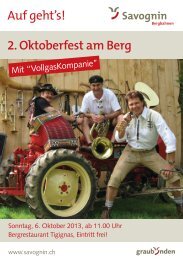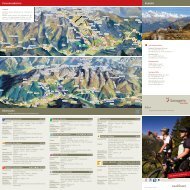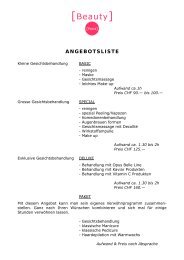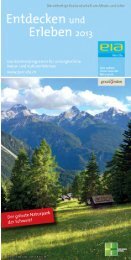Spassegio cultural tras vischnanca - Savognin
Spassegio cultural tras vischnanca - Savognin
Spassegio cultural tras vischnanca - Savognin
You also want an ePaper? Increase the reach of your titles
YUMPU automatically turns print PDFs into web optimized ePapers that Google loves.
Nr. 11: The church Son Martegn<br />
La Gloria del Paradiso (1677)<br />
The church Son Martegn<br />
The present-day church was consecrated in 1677. On a<br />
surface of about 100m2 the master Carlo Nuvolone from<br />
Milano painted «La Gloria des Paradiso» with 485 creatures.<br />
This artwork is considered to be the most significant baroque<br />
ceiling painting in Grisons. Archaeological excavations prove<br />
that a church was standing in the same place as early as in the<br />
7th/8th century. St. Martin was the first church in <strong>Savognin</strong>,<br />
followed by St. Michael built in the 8th/9th century. The appeal<br />
of the present-day church lies in its size and its simplicity.<br />
Note worthy is the altar from 1738, a work of craftsman Gion<br />
Tin from Tiefencastel, who created also the pulpit. Worth<br />
seeing is also the cemetery with many wrought-iron crosses.<br />
There are two bells hanging in the tower, the smaller dating<br />
from 1478 and the latin inscription «O rex glorie-veni cum<br />
pace» (Oh Lord of glory, come with peace). Enjoy the view of<br />
the beautiful mountainside in front of the church.<br />
«Sur Tocf» or «Son Martegn» is one of the oldest parts of the<br />
village. Bonifazi Plaz, who grew up in Sur Tocf, mentions in<br />
his script «<strong>Savognin</strong>, my home town» that there were 40 men<br />
fit for military service living there correlating to a total of about<br />
200 inhabitants. The priest is also said to have lived in Son<br />
Martegn until 1606 or maybe even until 1640. Even today<br />
you can see some buildings from the 16th century. They have<br />
been lovingly restored and some of them are nowadays even<br />
inhabited all-year round.<br />
The tuffstone, romansh «crap da tocf», at the entrance of<br />
the settlement on which there is a crucifix of Toni Dominik<br />
Schwab, gave the name to that part of the village.<br />
– 66 – – 67 –
















